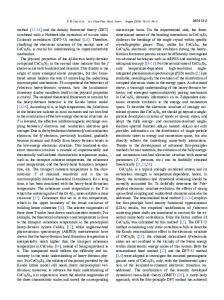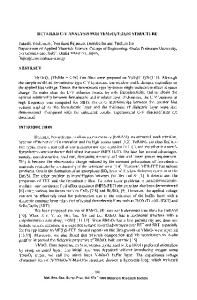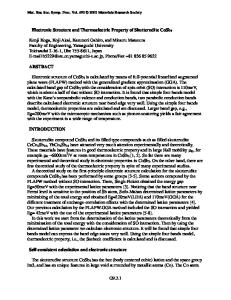Electronic Structure of Ru 2 Si 3
- PDF / 393,219 Bytes
- 8 Pages / 420.48 x 639 pts Page_size
- 76 Downloads / 384 Views
ELECTRONIC STRUCTURE OF Ru 2 Si 3 P. PECHEUR AND G.TOUSSAINT Laboratoire de physique du solide Ecole des Mines, Parc de Saurupt, 54042 Nancy Cedex France
ABSTRACT: The electronic structure of Ru2§Si 3 has been calculated with the empirical tight binding method and the recursion procedure. The calculation strongly indicates that there exists a gap in the structure, which makes Ru2Si 3 semiconducting, as found experimentally and explains the stability of the chimney-ladder phases for a valence electron concentration per transition metal atom smaller than 14. INTRODUCTION Ru 2 Si3 is a semiconducting compound which has been recently identified as a promising thermoelectric material. Both its gap and transport parameters (at least for p-type) are encouraging [1]. Ru2 Si3 is a member of a large family of transition metals compounds known as Nowotny "chimney-ladder" structures [2,3]. The unit cell in this family consists of a chimney-ladder of subcells, each of which is itself similar to the TiSi2 unit cell [4]. The transition metal atoms occupy a regular sublattice similar to that of p-tin, while the silicon atoms sites vary slightly from subcell to subcell. A striking feature of these compounds is that their composition is controlled by valence-electron concentrations in such a way that the the number of valence electrons per transition-metal site (VEC) practically never exceeds the 'magic' number of 14. In many of these structures the non-transition element sublattice appears to adjust itself so as to realize this VEC. Moreover a VEC of 14 appears to be a good criterion for the occurrence of a band gap, as is the case for Ru2Si3 or at least for a deep minimum at the Fermi level, as in MoSi2 or WSi2 . This suggests that the VEC=14 gap is between bonding and antibonding states of the structure, which loses its stability for a VYEC >14. It has even been suggested that this VEC=14 might correspond to a complete filling of the 10 transition metal d states and 4 s-p valence bands similar to those of #-Sn [2,3,5]. The purpose of the present work is to calculate the electronic structure of Ru2Si3 with the empirical tight binding method [6]. This method is simple enough to allow an easier treatment of the complex structure of Ru2Si3 (with a unit cell of 40 atoms) than first principle APW-like methods. COMPUTATIONAL PROCEDURE The empirical tight binding method uses a restricted basis of atomic like wavefunctions. The matrix elements of the Hamiltonian are not calculated from these wavefunctions but their values are obtained from fits to the known band structure of other solids. Our model includes 3s and 3p valence orbitals for Si and 4d, 5s and 5p valence orbitals for Ru. As a starting point the Hamiltonian matrix elements are deduced from the values tabulated by Papaconstantopoulos [7] for metallic Ru and semiconducting Si. Two centers, orthogonal parameters are used. Interactions between atoms are taken into account up to interatomic distances of 3.1 A This includes the first neighbors Ru-Ru interactions on their fl-tin subl
Data Loading...











